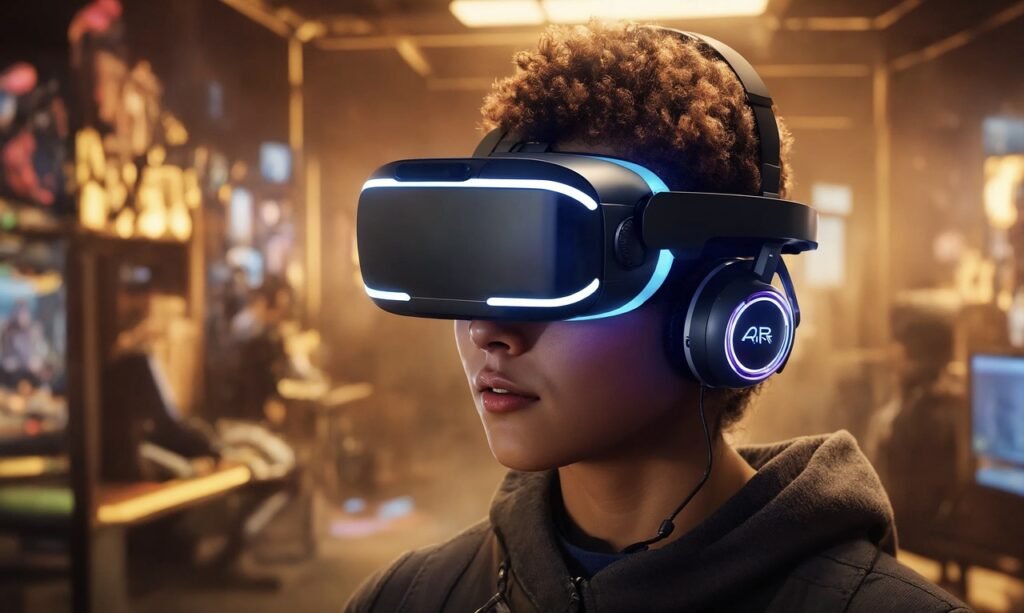This Article has been revised, edited and added to, by Poulomi Chakraborty.
- The Rise of Artificial Intelligence in Marketing
- The Expanding Realm of Voice Search Optimization
- The Integration of Augmented Reality in Digital Marketing
- The Surge of Interactive Content in Digital Marketing
- The Growth of Video Marketing and Live Streaming
- The Emergence of Influencer and Micro-Influencer Marketing
- Integrating Influencer Marketing into Your Overall Digital Strategy
- Aligning Influencer Marketing with Brand Goals
- Identifying the Right Influencers
- Strategic Content Collaboration
- Cross-Promotion Across Channels
- Regular Monitoring and Optimization
- Legal and Ethical Considerations
- Building Long-Term Relationships
- Leveraging Influencer Insights for Broader Marketing Strategies
- A Unified Marketing Ecosystem
- Conclusion
The landscape of digital marketing never stops evolving. With technology sprinting forward, what works today might be outdated tomorrow. For businesses wanting to stay ahead, understanding the emerging trends is crucial. Over the next five years, we’ll see shifts that could redefine how we connect with our audiences online. From AI-driven personalization to the rise of voice search optimization, this article dives deep into what the future holds and how you can prepare for it.
The Rise of Artificial Intelligence in Marketing

In recent years, artificial intelligence (AI) has started to reshape many industries, and digital marketing is no exception. As we look ahead, AI’s role is set to grow, fundamentally changing how businesses interact with customers and manage their campaigns. Let’s compare this future trend with a current staple in digital marketing: social media advertising.
Current Staple: Social Media Advertising
Today, social media advertising is a cornerstone of most marketing strategies. Businesses of all sizes use platforms like Facebook, Instagram, and Twitter to target specific audiences, deliver personalized ads, and track the effectiveness of their campaigns in real-time. This approach relies heavily on human input for content creation, audience targeting, and performance analysis.
Emerging Trend: AI-Driven Marketing
In contrast, AI-driven marketing promises a shift towards more automation and precision. AI technologies can analyze vast amounts of data faster and more accurately than humans ever could. This capability enables marketers to understand consumer behavior and preferences at an unprecedented level.
Strategic Comparison
- Campaign Optimization: AI can continuously analyze campaign performance and automatically adjust bids, target new audiences, and even optimize ad creatives without human intervention. This not only saves time but also enhances the effectiveness of campaigns by making real-time adjustments that are not feasible manually.
- Personalization at Scale: While social media allows for some level of personalization in advertising, AI can take this to a new level. By processing data from various sources, AI can help create hyper-personalized messages that speak directly to the user’s current needs and interests, potentially increasing engagement rates.
- Predictive Analytics: AI excels in identifying patterns and predicting future behavior based on historical data. In digital marketing, this means being able to predict which products a customer is likely to purchase, when they might be ready to buy, and what kind of messaging will most likely convert them.
- Cost Efficiency: AI reduces the cost of acquiring new customers by optimizing the marketing funnel and improving conversion rates. It can identify the most effective marketing channels and allocate budget accordingly, reducing wasted ad spend on underperforming channels.
In essence, while social media advertising allows for targeted and dynamic marketing strategies, AI-driven marketing offers the promise of even greater personalization, efficiency, and predictive power. Over the next five years, we expect AI to become a fundamental part of digital marketing, transforming how businesses understand and interact with their customers.
The Expanding Realm of Voice Search Optimization

As digital assistants like Siri, Alexa, and Google Assistant become fixtures in our homes and on our phones, the way people search for information online is undergoing a transformation. Voice search is not just a trend; it’s becoming a key component of online interactions. This shift has profound implications for digital marketing strategies.
Understanding Voice Search Optimization
Voice search optimization is about adapting your online content to the way people speak rather than the way they type. When people use voice to search, their queries tend to be longer, more conversational, and more specific than the concise phrases typically entered into a search engine.
The Shift from Typed to Spoken Queries
This shift from typed to spoken queries requires a different approach to content creation and SEO. Traditional keyword strategies focused on short, often vague terms are less effective for voice search. Instead, the focus shifts to long-tail keywords and questions that mimic natural speech.
Tactical Implementation of Voice Search Strategies
- Focus on Natural Language: Content that incorporates natural language with a conversational tone tends to perform better in voice search results. This involves using full sentences and questions that people are likely to ask. For example, instead of targeting keywords like “best running shoes,” you might optimize for a full question like “What are the best running shoes for a marathon?”
- Utilize Schema Markup: Schema markup helps search engines understand the context of your content, making it easier to match it with the appropriate voice queries. Implementing schema markup can help your content appear in rich snippets, which are often used to provide direct answers in voice searches.
- Optimize for Local Search: Voice searches are frequently used to find local information, such as nearby restaurants or stores. Ensuring that your business’s local SEO is top-notch can help you capture this traffic. This includes optimizing your Google My Business listing and making sure your NAP (Name, Address, Phone number) information is consistent across the web.
- Create FAQ Pages: Since voice searches are often phrased as questions, having a dedicated FAQ page on your website can be particularly effective. Each question on your FAQ page should target a common voice search query related to your business or industry, with detailed, well-structured answers.
The Strategic Advantage
Voice search optimization offers a strategic advantage by aligning your brand with the evolving ways consumers access information. Businesses that excel in voice search optimization can increase their visibility significantly, especially in local search results. This is crucial because voice search users are often in the later stages of the decision-making process, looking to make a purchase or visit a business location imminently.
The rise of voice search is an exciting opportunity for marketers to rethink their content strategies and engage with users in new ways. As this technology continues to develop, its impact on digital marketing strategies will only grow, making it essential for businesses to start adapting now.
The Integration of Augmented Reality in Digital Marketing

Augmented reality (AR) is poised to become a transformative force in digital marketing. This technology, which overlays digital information on the real world, offers exciting new ways for brands to engage with consumers. Over the next five years, we can expect AR to move from novelty to a mainstream strategy in marketing campaigns.
The Power of AR in Consumer Engagement
AR allows consumers to interact with products or experiences in a deeply immersive way. For example, furniture retailers like IKEA already use AR to let customers visualize how a piece of furniture would look in their own homes before making a purchase. This capability not only enhances the shopping experience but also helps in reducing return rates by providing customers with a better understanding of the product.
How AR Can Elevate Marketing Strategies
- Enhanced Product Previews: AR provides customers with a virtual preview of products, which can be particularly beneficial for online shopping where the physical touchpoint is missing. This can apply to a wide range of industries, from trying on clothes virtually to visualizing how a new makeup shade would look.
- Interactive Advertisements: AR can transform traditional ads into interactive experiences. For instance, a movie poster could come to life when viewed through a smartphone camera, displaying a trailer, additional content, or interactive elements that encourage direct engagement with the product.
- Innovative Brand Experiences: Brands can create unique marketing campaigns that integrate AR to offer memorable experiences. These could include virtual tours, scavenger hunts, or interactive story-driven experiences that enhance brand recognition and loyalty.
Implementing AR in Your Digital Marketing Strategy
- Start Small: If you’re new to AR, consider starting with small, pilot projects to gauge customer response and interaction. This could be as simple as an AR-enhanced social media filter or a small feature in your mobile app.
- Focus on Value: Ensure that any AR implementation adds value to the customer experience. It should solve a problem or enhance the customer’s interaction with your brand, not just serve as a gimmick.
- Leverage Mobile Technology: Since most AR experiences today are accessed through smartphones, ensure that your AR features are optimized for mobile devices. This includes responsive design and considering the limitations and capabilities of current mobile technology.
- Collaborate with Tech Experts: Developing AR applications can be complex. Partnering with technology providers specializing in AR can help ensure that your projects are both feasible and successful.
Strategic Impact of AR
The strategic impact of AR in digital marketing is substantial. It not only provides a novel way to engage customers but also offers a competitive edge to brands that adopt it early. As AR technology becomes more accessible and user-friendly, its integration into marketing strategies will likely become a standard practice, reshaping how brands interact with their audiences.
Augmented reality holds a promising future in digital marketing, with the potential to merge the digital and physical worlds in ways that were previously unimaginable. This technology not only enhances the consumer experience but also provides marketers with powerful tools to capture attention in an increasingly crowded digital landscape.
The Surge of Interactive Content in Digital Marketing

Interactive content is not just a fleeting trend—it’s becoming a cornerstone of digital marketing strategies. As we look to the future, this form of content is expected to dominate, offering new ways for brands to engage with their audience and gather valuable data. Over the next five years, interactive content will evolve from simple quizzes and polls to more sophisticated, immersive experiences that leverage the latest web technologies.
Understanding Interactive Content
Interactive content includes anything that requires and responds to users’ active engagement, rather than passive consumption. Examples include quizzes, polls, surveys, interactive videos, and calculators. This type of content is highly engaging because it involves the audience directly and can provide a personalized experience based on their responses.
Why Interactive Content Appeals to Modern Consumers
- Increased Engagement: Interactive content naturally leads to increased engagement because it requires active participation. The more engaged users are, the more likely they are to develop a connection with the brand and remember the content they interacted with.
- Enhanced Personalization: Interactive tools can adapt the content based on the inputs from the user, providing a personalized experience that static content cannot match. This level of personalization is appealing to consumers who increasingly expect experiences tailored to their preferences and behaviors.
- Better Data Collection: By encouraging users to interact, brands can gather more detailed data on their preferences, behaviors, and needs. This data is invaluable for refining marketing strategies and improving customer understanding.
Strategies for Implementing Interactive Content
- Identify the Right Tools: Depending on your audience, certain types of interactive content might be more effective. For instance, B2B companies might find value in interactive whitepapers or ROI calculators, while B2C brands might see better engagement from interactive videos or quizzes.
- Focus on Storytelling: Interactive content should tell a story. Whether it’s guiding users through a scenario or letting them explore different outcomes based on their choices, the narrative can drive deeper engagement and make the experience memorable.
- Integrate with Other Marketing Channels: Interactive content should not stand alone. Integrating it with other elements of your marketing strategy, such as social media, email, or your website, can enhance its reach and effectiveness. For example, embedding a quiz in a blog post or sharing it on social media can drive more interaction.
- Measure and Optimize: Like all digital marketing efforts, interactive content should be continually measured and optimized based on performance metrics. Analyzing how users interact with your content can provide insights into what works and what doesn’t, allowing for real-time adjustments and improved effectiveness over time.
Long-Term Benefits of Interactive Content
The long-term benefits of implementing interactive content into your digital marketing strategy are significant. Not only does it increase user engagement and satisfaction, but it also enhances brand perception as innovative and customer-focused. Furthermore, the rich data collected from interactions can be leveraged to personalize future marketing efforts and improve overall marketing ROI.
As digital technologies continue to evolve, the possibilities for interactive content are bound to expand, offering even more creative ways to engage audiences. Companies that invest in this trend now will be well-positioned to benefit from its growth in the coming years.

Related: Check out our free SEO suite

The Growth of Video Marketing and Live Streaming
Video marketing and live streaming are set to dominate the digital landscape over the next five years, revolutionizing how brands connect with their audience. As consumer attention spans shorten and the demand for engaging content increases, video offers a dynamic and effective way to capture interest and convey information.
Evolution of Video Marketing
Video marketing is not new, but its role and impact continue to evolve rapidly. With advancements in technology and changes in consumer behavior, video has moved from a nice-to-have feature to a central component of marketing strategies across various platforms. It’s more accessible than ever, with tools and platforms simplifying the creation and distribution of high-quality video content.
Why Video Content Captures Consumer Interest
- Enhanced Engagement: Videos are inherently more engaging than static images or text. They can convey emotion and information within seconds, capturing the viewer’s attention quickly and effectively.
- Higher Retention Rates: Viewers retain significantly more information from videos compared to text. This makes video an excellent tool for tutorials, explanations, and storytelling, helping brands educate their audience more effectively.
- Better Conversion Rates: Videos have been shown to improve conversion rates in marketing campaigns. They can be persuasive and lead directly to sales, making them a powerful tool in any marketer’s arsenal.
Live Streaming as a Growing Trend

Live streaming adds an element of immediacy and interactivity to video content that recorded videos cannot match. Platforms like Twitch, YouTube Live, and Facebook Live have popularized this format, making it an integral part of social media strategies.
Strategic Use of Live Streaming
- Real-Time Engagement: Live streaming allows for real-time interaction with the audience, making viewers feel more connected to the brand. This interaction can be leveraged to gather immediate feedback, answer questions, and personalize the experience.
- Event Marketing: For events, live streaming can significantly extend your reach, allowing people who cannot attend in person to participate virtually. This is beneficial for maximizing the impact of key events such as product launches, webinars, or educational sessions.
- Building Community: Regular live streams can help build and maintain an online community, fostering a sense of loyalty and belonging among viewers. This community becomes a valuable asset for brands, contributing to sustained engagement and advocacy.
Integrating Video and Live Streaming into Marketing Strategies
- Content Diversity: Incorporate a mix of live and recorded video content to keep your audience engaged. Utilize live streaming for events and announcements and recorded videos for detailed tutorials, customer testimonials, and behind-the-scenes content.
- Accessibility and SEO: Ensure that your video content is accessible to all users, including those with disabilities. Use captions, descriptive audio, and proper tagging to improve accessibility and SEO.
- Analytics and Feedback: Utilize analytics tools provided by platforms to track the performance of your video content. This data is crucial for understanding viewer preferences and optimizing your video strategy for better results.
The Emergence of Influencer and Micro-Influencer Marketing
As we look ahead to the next five years in digital marketing, the role of influencers and micro-influencers is set to expand significantly. This trend capitalizes on the trust and rapport that these individuals have built with their followers, offering brands a more organic way to reach audiences.
Understanding Influencer Marketing
Influencer marketing involves partnering with individuals who have a significant following on social media or other digital platforms to promote products, services, or campaigns. These influencers can range from celebrities with millions of followers to micro-influencers who may have fewer followers but boast high engagement rates.
Why Micro-Influencers Are Gaining Ground
Micro-influencers, typically defined as having 1,000 to 100,000 followers, are becoming particularly valuable for digital marketing due to their niche audiences and perceived authenticity. These influencers often have a stronger connection with their audience, which can lead to higher engagement rates compared to their more famous counterparts.
Strategic Benefits of Micro-Influencer Partnerships
- Higher Engagement Rates: Micro-influencers tend to have more targeted audiences who are deeply interested in their content. This can result in higher engagement rates, as their recommendations are seen as more genuine and relevant.
- Cost-Effectiveness: Working with micro-influencers is often more cost-effective than engaging with high-profile influencers. This makes it an accessible strategy for brands of all sizes, particularly startups and smaller businesses.
- Increased Credibility and Trust: Audiences trust micro-influencers more than traditional advertising because they view them as peers. This trust can translate into more effective endorsements and higher conversion rates.
Implementing a Micro-Influencer Strategy
- Identify the Right Influencers: It’s crucial to partner with influencers whose followers align with your target audience. Tools like BuzzSumo or Upfluence can help identify influencers with the best engagement and audience demographics for your brand.
- Build Genuine Relationships: Instead of one-off campaigns, focus on building long-term relationships with influencers. This fosters a more authentic connection between the influencer and your brand, which their audience can sense.
- Leverage Diverse Content Formats: Encourage influencers to use a mix of content formats, such as videos, blogs, and live streams, to promote your brand. This variety can help maintain audience interest and cater to different preferences within the influencer’s following.
- Measure and Optimize: Like any marketing strategy, it’s important to track the performance of your influencer campaigns. Analyze metrics like engagement rate, click-through rate, and conversion rate to assess the effectiveness of each influencer and refine your approach accordingly.
The Future of Influencer Marketing
Looking forward, the influence of digital creators shows no signs of waning. As platforms evolve and new ones emerge, the strategies for influencer marketing will also need to adapt. Brands that can stay ahead of these changes and continue to harness the power of influencers in innovative ways will likely see significant advantages.
Influencer marketing, particularly through micro-influencers, offers a powerful tool for brands looking to deepen their connection with specific audiences. By embracing this trend, marketers can leverage the authenticity and engaged communities of these influencers to dramatically enhance their digital marketing efforts.
Integrating Influencer Marketing into Your Overall Digital Strategy

Successfully incorporating influencer marketing into your overall digital strategy involves more than just selecting influencers and launching campaigns. It requires a cohesive approach that aligns with your broader marketing objectives and leverages the unique strengths of influencers to enhance your brand’s online presence.
Aligning Influencer Marketing with Brand Goals
The first step in integrating influencer marketing is to ensure that it supports your overarching brand goals, whether that’s increasing brand awareness, driving sales, or entering new markets. Each influencer campaign should have clear objectives that complement your other marketing efforts.
Identifying the Right Influencers
Choosing the right influencers is critical. This means more than just looking at the number of followers; it involves analyzing their audience demographics, engagement rates, and alignment with your brand’s values. Tools like HypeAuditor or Klear can provide detailed insights into an influencer’s audience, helping you make informed decisions.
Strategic Content Collaboration
Once you’ve identified suitable influencers, collaborate with them to create content that feels authentic and resonates with their audience as well as yours. Influencers know their audience best, so it’s important to give them the creative freedom to present your brand in a way that feels natural. This could include co-creating content, hosting joint events, or running exclusive promotions.
Cross-Promotion Across Channels
To maximize the impact of your influencer partnerships, coordinate content across all your digital channels. For example, if an influencer promotes your product on Instagram, consider featuring that content on your brand’s Facebook page, in your email newsletters, or even on your website. This not only extends the reach of the original content but also provides your audience with a cohesive brand message.
Regular Monitoring and Optimization
Like any marketing initiative, influencer marketing should be regularly monitored and optimized based on performance data. Track metrics such as engagement, reach, and conversion rates to evaluate the effectiveness of each influencer and campaign. This data can help you refine your strategy, making informed decisions about which partnerships to continue or adjust.
Legal and Ethical Considerations
Ensure compliance with advertising standards and regulations, such as disclosing sponsored content. This transparency builds trust with your audience and protects your brand’s reputation.
Building Long-Term Relationships
Consider developing long-term relationships with key influencers. This can lead to ongoing collaborations that build stronger associations between the influencers and your brand, making their endorsements more impactful over time.
Leveraging Influencer Insights for Broader Marketing Strategies
Influencers can provide valuable insights into consumer behaviors and preferences. Engage with them to gather feedback on your products or market trends, which can inform broader marketing strategies and product development.
A Unified Marketing Ecosystem
Integrating influencer marketing into your overall digital strategy can dramatically enhance your brand’s reach and relevance in the digital age. By aligning influencer activities with your marketing goals, fostering authentic content creation, and optimizing based on performance, you can create a powerful, unified marketing ecosystem that resonates with today’s consumers.
Conclusion
In conclusion, as we navigate the rapidly evolving landscape of digital marketing, staying ahead of trends like AI-driven marketing, voice search optimization, augmented reality, video content, and influencer marketing is essential. Each of these trends offers unique opportunities to enhance engagement, improve personalization, and increase efficiency. By strategically integrating these innovative practices into your marketing efforts, you can create a more dynamic, responsive, and effective marketing strategy that resonates with today’s digital-first audience.
Embracing these trends not only prepares your business for future changes but also sets you apart in a competitive market. Remember, the key to successful digital marketing lies in understanding these trends, adapting to new technologies, and continually optimizing your strategies to meet the ever-changing preferences of consumers. By doing so, you can build stronger connections with your audience and drive sustained growth for your business.
Read Next
- Local SEO Tactics for Green Brick-and-Mortar Businesses
- User-Generated Content: Harnessing Reviews and Testimonials for Alternative Energy Startups
- Using Video Content to Boost Your Green Startup’s SEO
- How to Promote Sustainable Stories through SEO for Sustainability-Focused Startups
- Crafting SEO-Friendly Content for Green Business Brands






















Comments are closed.